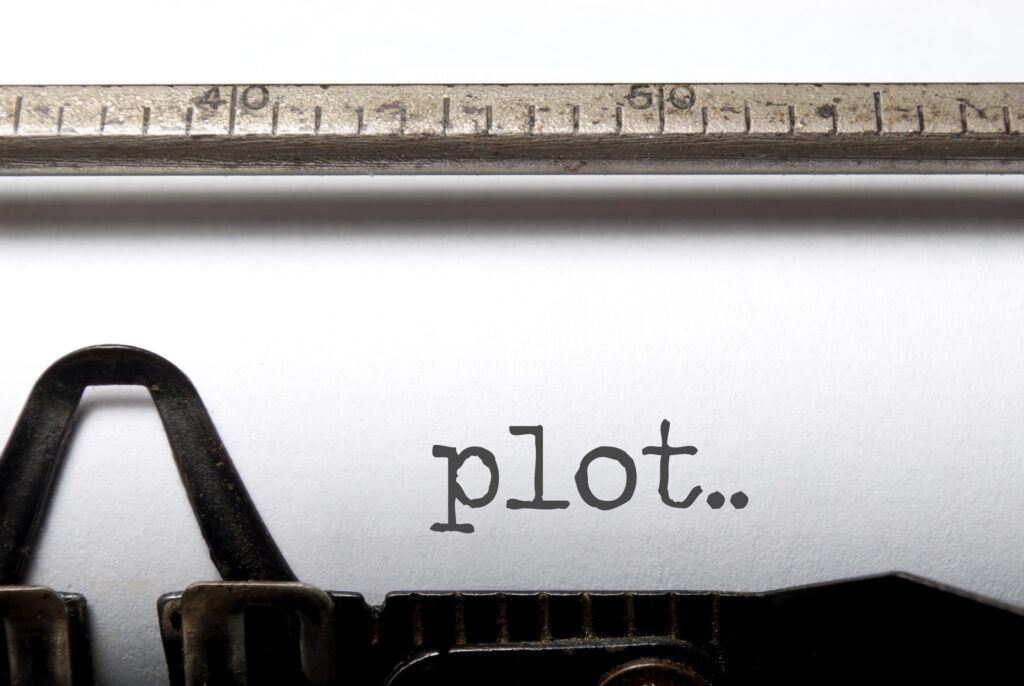Are you a novelist (or hopeful) but finding it challenging to determine your starting point? Perhaps you write to discover what you’re trying to say planning everything out ahead of time. Maybe you’re not a planner at all, and you write from the seat of your pants.
Regardless of your current approach, having an outline before you start writing is a valuable aid when it comes to story plotting. Because it can be helpful to know where it’s going to understand where to start.
This article explores why an outline could be your new best friend.
Are you a pantser?
If you’re a “pantser”, you write without formal planning (literally, from the seat of your pants). You trust you’ll find your way as you go. You might not have the plot clear in your head; perhaps you just have an intriguing character.
Indeed, writing from the seat of your pants can be a great way to explore characters, worlds, and conflicts.
But:
Pantsers can lose focus because they’re not always entirely sure where the story is going, which can make it difficult to finish and wrap up story threads.
Are you a planner?
On the other hand, some of us are planners — we like to have the plot’s framework laid out before putting pen to paper.
This approach is helpful because:
- You know where the story is going, and
- You understand your ending.
And this furnishes us with a great place to start.
Where do you begin your story?
Remember, the opening of a book is about establishing:
- A problem that’s going to challenge the protagonist to make difficult decisions.
- A protagonist driven by an objective (to solve the problem).
- A conflict that prevents the protagonist from too easily achieving their objective (this makes it more exciting!).
Typically, a story’s journey takes us from problem to solution while the protagonist learns something about themselves along the way.
So, an outline guides you into the fun part — the writing — with razor-sharp focus, preventing your characters from meandering from one dead end into another.
What is an outline (and why does it help?)
A story outline provides the bones of the story, offering a basic framework from which to work. It can be as simple as a basic path of character action, or it could be more detailed, including the prime story locations for feeding revelations to the reader.
Outlining gives you a chance to:
- Explore ideas more thoroughly before committing them to the page, and
- Find potential alternative routes or problems before you’ve written your first chapter.
Ultimately, laying out your plot allows you to workshop your ideas, ensuring the action remains well-paced, logical, fluid, and focused.
An outline helps you determine your character’s arc, helping keep the audience focused on the story.
Because:
Plot holes take the reader out of the action — and the more this happens, the more likely the reader will give up before they get to the end of your novel.
Does an outline stifle creativity?
An outline is a valuable map covering logical plot points, but you should never feel trapped by the predetermined framework. Indeed, you may find new moments that veer away from the outline, allowing you to explore the character’s motivations in more detail.
So:
While an outline is a great starting point, you can still work spontaneously. But, essentially, the outline will allow you to get back onto the path of action more quickly.
What are the characteristics of a good outline?
A good novel outline helps with your story’s structure and plot, including a detailed framework of the protagonist’s emotional arc.
The most basic outline ensures your story has a beginning, a middle, and an end.
- The beginning throws us into the protagonist’s world, where they struggle with a new (or existing) problem.
- In the middle, the protagonist follows an objective they think will solve the problem (but doesn’t).
- During the ending, the protagonist realises what WILL ultimately solve the problem and sets about enacting it.
To bring more flesh to this concept, we could consider three essential concepts: contract, time pressure, and stakes.
Novel’s “main contract”
Ask yourself, “What is the story’s ‘contract'” (or what are the promises you make to your reader)?
For example, if you promise romance, ensure the story delivers a heart-pounding tale of love with a happily ever after. If you tease dragons on the cover, they must be central to your novel.
A well-thought out outline will aid you in satisfying your readers’ expectations.
Time pressure
Consider a common objective in romantic fiction: John is a busy executive working in his family business with plans to become CEO. He sees himself getting married. One day. But not yet. He thinks there’s plenty of time to find a partner, so for the first three-quarters of the book, we see John doing everything except finding someone he might consider as a partner.
Which isn’t very interesting…
So, give him a deadline. John’s just found out that he’s in competition with his (married) cousin for the position and if he has any hope of becoming CEO, he has to get married within the next 3 or 6 months. His favourite cousin’s wedding is next month, and this is the perfect opportunity to show that he’s serious about the CEO position. And with all the important family members planning to attend, it’s the perfect time to introduce everyone to his fiancée. He just has to find her.
Stakes
What does the protagonist lose if they don’t achieve their objective? Ideally, it’s everything, because that will make them battle all the harder to win.
If they stand to lose nothing, there’s not much stopping them from giving up!
In John’s case: he’ll lose everything he’d been working for his entire adult life. Even worse, his cousin has plans to divest part of the company once he’s in position, which means John’s family legacy will be no more.
Push your characters into corners and make them respond emotionally — it makes for a much more gripping story!
Different types of novel outlines
There are six principal styles of novel outline, each with varying levels of detail. These are:
- Mind maps
- Synopsis
- Beat sheet
- Story skeleton
- Character journey
- Scene breakdown
Mind maps
A mind map outline offers a visual way to represent your story ideas.
This approach maps out the character relationships in story beats or chapters, although you can also lay out the external pressures or explore the total narrative.
This is a great way to plan large-scale or epic stories, where characters find themselves in conflicts that manifest from tensions of the past — especially useful for thrillers, detective stories, and sci-fi chronicles.
Synopsis
This outline most resembles a two-to-three-page essay, providing lots of essential detail.
The synopsis includes detailed insight into:
- Character arcs,
- Conflicts,
- Resolutions, and
- Background that informs the action of the present within the story.
To turn your synopsis outline into a full novel, you’ll take the broad-stroke details and add mystery, tension, suspense, world-building, and stunning prose to bring it alive.
Beat sheet
This is a more “bare bones” outline that simply bullet-lists the story “beats”.
A beat is a turning point within the story that moves the plot forward. It could be a character decision that affects the plot or a new external tension that injects some emotional weight into your story.
Story beats keep the action moving and — most importantly — keep your reader turning the pages.
Story skeleton
As the name suggests, the skeleton is the ultimate bare-bones outline, simply listing the key plot points to cover.
The skeleton might give you locations that drive the story.
For example, your character might leave their hometown and seek the answers in Las Vegas. But the answers they find there might lead them to LA, then to New York, where the character finally solves the problem.
The skeleton is necessarily vague, allowing you to figure out the details in between.
Character journey
The character journey outline is most often assimilated with the traditional 3-act structure, following the story beats that show us how the character goes from powerless to powerful in some way.
However, “powerful” doesn’t mean they develop the ability to fly or become a tycoon. It could, of course, but it more often means that they overcome the problem holding them back at the story’s opening.
Check out our article on understanding conflict for tips on the three-act structure.
Scene breakdown
This detailed document outlines each chapter of the book, breaking it down into individual scenes, allowing you to determine the story’s organic movement and recognise how each scene’s action impacts the next.
Some chapters take several pages of notes, while others might be more direct and open — “John realizes there more going on with his family’s business and while solving the mystery, discovers the truth about his dad”.
Remember: you might not be able to write the entire scene breakdown before you start writing, but leaving gaps is okay because you’ll find the answers to your questions as you write.
Should I outline my novel or simply start writing?
You might feel that using an outline will constrict your creativity. But once you get used to them, you’ll learn that isn’t the case.
Taking the extra time to outline your novel before you begin writing will aid you throughout the writing process.
Need to take a break from your writing due to other commitments (work, family, illness)? Your outline will help you get reorientated to the story fast.
Partway into the writing process and hit a snag? You can return to the outline to determine what needs to change and be able to determine how that will impact the end.
Learning to write using an outline will allow you to keep the primary components of the story in focus while leaving you room to add the level of creativity that will make your novel stand out.
What to avoid when outlining
Limit the amount of time you spend developing your outline because continually re-writing it isn’t going to get your book written!
Don’t worry about gaps — those will fill themselves in eventually. If you get stuck at a plot point in your outline, jump onto more certain ground and allow the gap to find its own path.
Remember:
Your outline is a guide, not the book!
Indeed, working with a provided outline ensures that you produce a real page-turner, and it’s a great way to learn the art of novel writing.
How ghostwriters use outlines
Ghostwriting is an excellent path to achieving your first publication. Indeed, some writers love ghostwriting so much that they spend their entire careers writing incognito!
Relay Publishing ghostwriters are presented with a story premise and a detailed outline, then paired with a dedicated and experienced editor to assist you throughout the process, which means you get to do the fun part: the writing!
Relay Publishing wants YOU!
Relay Publishing has a catalogue of more than 1000 books distributed in digital and print form all around the world. We work with talented ghostwriters paired with creative, experienced editors to bring exciting story ideas to life in a wide range of genres, from thrillers to romance and YA fiction to sci-fi.
So, if you think you have what it takes to be a great novelist, find out more about our recruitment opportunities, and get in touch.
We can’t wait to hear from you!



